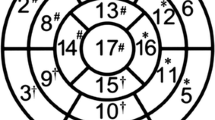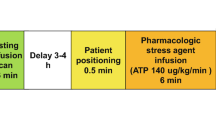Abstract
Purpose
The aim of this study was to evaluate spiral multidetector computed tomography (MDCT) angiography using 64-slice technique in the detection of functionally relevant coronary artery stenoses (CAS).
Methods
Thirty-eight patients (62±11 years, 28 men) with stable angina (26 with suspected and 12 with known coronary artery disease) were investigated using 64-slice MDCT angiography and gated myocardial perfusion SPECT (gated SPECT); a subgroup of 30 patients had additional invasive coronary angiography (ICA). Stenoses with luminal narrowing of ≥50% were defined as “significant” in MDCT angiography and ICA. MDCT angiography was compared with gated SPECT and the combination of gated SPECT plus ICA with respect to the detection of functionally relevant CAS.
Results
The sensitivity, specificity and negative and positive predictive values of MDCT angiography in detecting reversible perfusion defects on gated SPECT were 63%, 80%, 94% and 32%, respectively, in vessel-based analysis and 71%, 62%, 72% and 60%, respectively, in patient-based analysis. If only reversible perfusion defects on gated SPECT with CAS ≥50% on ICA were considered, the sensitivity, specificity and negative and positive predictive values were, respectively, 85%, 79%, 98% and 33% for vessel-based analysis and 85%, 59%, 83% and 61% for patient-based analysis.
Conclusion
Sixty-four slice MDCT angiography failed to predict the functional relevance of CAS, but had a high negative predictive value in the exclusion of functionally relevant CAS in symptomatic patients.

Similar content being viewed by others
References
Mollet NR, Cademartiri F, van Mieghem CA, Runza G, McFadden EP, Baks T, et al. High-resolution spiral computed tomography coronary angiography in patients referred for diagnostic conventional coronary angiography. Circulation 2005;112(15):2318–23.
Mollet NR, Cademartiri F, van Mieghem CA, Runza G, McFadden EP, Baks T, et al. High-resolution spiral computed tomography coronary angiography in patients referred for diagnostic conventional coronary angiography. Circulation 2005;3:3.
Leschka S, Alkadhi H, Plass A, Desbiolles L, Grunenfelder J, Marincek B, et al. Accuracy of MSCT coronary angiography with 64-slice technology: first experience. Eur Heart J 2005;26(15):1482–7.
Pugliese F, Mollet NR, Runza G, van Mieghem C, Meijboom WB, Malagutti P, et al. Diagnostic accuracy of non-invasive 64-slice CT coronary angiography in patients with stable angina pectoris. Eur Radiol 2006;16(3):575–82.
Leber AW, Knez A, von Ziegler F, Becker A, Nikolaou K, Paul S, et al. Quantification of obstructive and nonobstructive coronary lesions by 64-slice computed tomography: a comparative study with quantitative coronary angiography and intravascular ultrasound. J Am Coll Cardiol 2005;46(1):147–54.
Leber AW, Knez A, Becker A, Becker C, von Ziegler F, Nikolaou K, et al. Accuracy of multidetector spiral computed tomography in identifying and differentiating the composition of coronary atherosclerotic plaques: a comparative study with intracoronary ultrasound. J Am Coll Cardiol 2004;43(7):1241–7.
Haberl R, Tittus J, Bohme E, Czernik A, Richartz BM, Buck J, et al. Multislice spiral computed tomographic angiography of coronary arteries in patients with suspected coronary artery disease: an effective filter before catheter angiography? Am Heart J 2005;149(6):1112–9.
Libby P. Current concepts of the pathogenesis of the acute coronary syndromes. Circulation 2001;104(3):365–72.
White CW, Wright CB, Doty DB, Hiratza LF, Eastham CL, Harrison DG, et al. Does visual interpretation of the coronary arteriogram predict the physiologic importance of a coronary stenosis? N Engl J Med 1984;310(13):819–24.
Topol EJ, Nissen SE. Our preoccupation with coronary luminology. The dissociation between clinical and angiographic findings in ischemic heart disease. Circulation 1995;92(8):2333–42.
Iskander S, Iskandrian AE. Risk assessment using single-photon emission computed tomographic technetium-99m sestamibi imaging. J Am Coll Cardiol 1998;32(1):57–62.
Gibbons RS. American Society of Nuclear Cardiology project on myocardial perfusion imaging: measuring outcomes in response to emerging guidelines. J Nucl Cardiol 1996;3(5):436–42.
Hacker M, Jakobs T, Matthiesen F, Vollmar C, Nikolaou K, Becker C, et al. Comparison of spiral multidetector CT angiography and myocardial perfusion imaging in the noninvasive detection of functionally relevant coronary artery lesions: first clinical experiences. J Nucl Med 2005;46(8):1294–300.
Kuettner A, Trabold T, Schroeder S, Feyer A, Beck T, Brueckner A, et al. Noninvasive detection of coronary lesions using 16-detector multislice spiral computed tomography technology: initial clinical results. J Am Coll Cardiol 2004;44(6):1230–7.
Imaging guidelines for nuclear cardiology procedures, part 2. American Society of Nuclear Cardiology. J Nucl Cardiol 1999;6(2):G47–84.
Sharir T, Berman DS, Waechter PB, Areeda J, Kavanagh PB, Gerlach J, et al. Quantitative analysis of regional motion and thickening by gated myocardial perfusion SPECT: normal heterogeneity and criteria for abnormality. J Nucl Med 2001;42(11):1630–8.
Lima RS, Watson DD, Goode AR, Siadaty MS, Ragosta M, Beller GA, et al. Incremental value of combined perfusion and function over perfusion alone by gated SPECT myocardial perfusion imaging for detection of severe three-vessel coronary artery disease. J Am Coll Cardiol 2003;42(1):64–70.
Smith SC Jr, Dove JT, Jacobs AK, Kennedy JW, Kereiakes D, Kern MJ, et al. ACC/AHA guidelines for percutaneous coronary intervention (revision of the 1993 PTCA guidelines)—executive summary: a report of the American College of Cardiology/American Heart Association Task Force on Practice Guidelines (Committee to revise the 1993 guidelines for percutaneous transluminal coronary angioplasty) endorsed by the Society for Cardiac Angiography and Interventions. Circulation 2001;103(24):3019–41.
Hoffmann U, Moselewski F, Cury RC, Ferencik M, Jang IK, Diaz LJ, et al. Predictive value of 16-slice multidetector spiral computed tomography to detect significant obstructive coronary artery disease in patients at high risk for coronary artery disease: patient- versus segment-based analysis. Circulation 2004;110(17):2638–43.
Hoffmann MH, Shi H, Schmitz BL, Schmid FT, Lieberknecht M, Schulze R, et al. Noninvasive coronary angiography with multislice computed tomography. JAMA 2005;293(20):2471–8.
Becker CR, Majeed A, Crispin A, Knez A, Schoepf UJ, Boekstegers P, et al. CT measurement of coronary calcium mass: impact on global cardiac risk assessment. Eur Radiol 2005;15(1):96–101.
Berman DS, Wong ND, Gransar H, Miranda-Peats R, Dahlbeck J, Hayes SW, et al. Relationship between stress-induced myocardial ischemia and atherosclerosis measured by coronary calcium tomography. J Am Coll Cardiol 2004;44(4):923–30.
Jakobs TF, Becker CR, Ohnesorge B, Flohr T, Suess C, Schoepf UJ, et al. Multislice helical CT of the heart with retrospective ECG gating: reduction of radiation exposure by ECG-controlled tube current modulation. Eur Radiol 2002;12(5):1081–6.
Acknowledgments
We are grateful for the support and technical assistance of the staff of the Departments of Nuclear Medicine and Radiology at the University of Munich.
Author information
Authors and Affiliations
Corresponding author
Additional information
An editorial commentary on this paper is available at http://dx.doi.org/10.1007/s00259-006-0204-5.
Rights and permissions
About this article
Cite this article
Hacker, M., Jakobs, T., Hack, N. et al. Sixty-four slice spiral CT angiography does not predict the functional relevance of coronary artery stenoses in patients with stable angina. Eur J Nucl Med Mol Imaging 34, 4–10 (2007). https://doi.org/10.1007/s00259-006-0207-2
Received:
Accepted:
Published:
Issue Date:
DOI: https://doi.org/10.1007/s00259-006-0207-2




